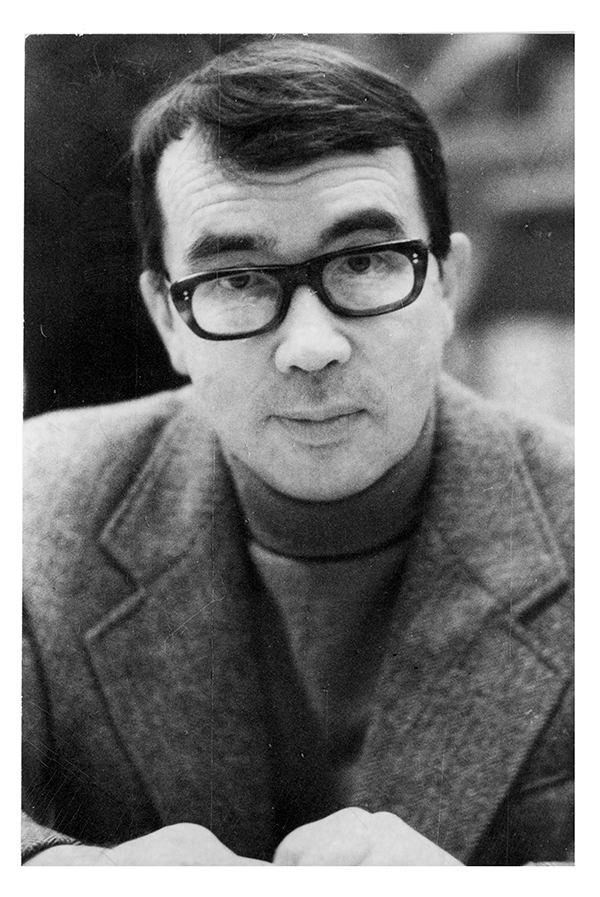
Valery Aleksandrovich Gavrilin (1939–1999) is the distinguished Russian composer, having lived in the last third of the 20th century. His creative work is considered to be the kind of brilliant and original side of the world music art. Gavrilin’s music style may be recognized at once, it has imitators. Gavrilin’s music wins the hearts by its natural melodic sphere, modern national colouring, cordiality and sincerity, deep heartfelt compassion to the common people’s troubles and aspirations. This music is fine and serious, it’s smiling and sad, it’s intimately trusty with the kind of a grand soul inside it.
Gavrilin was born in Vologda in the family of the teachers. In 1941 Valery’s father went to the Great Patriotic war as a volunteer and soon perished at the front. Quite accidently the ten years old boy occurs at the children’s home in the village Kovyrino near Vologda.
This time is marked by the beginning of music studying in the Vologda children’s music school № 1. In 1953 the talented boy is discovered there by the Leningrad conservatoire senior lecturer I. M. Belozemtsev. He offers Valery to come to Leningrad. Later the young musician was taken to the seventh form of the Special music school at the conservatoire to the clarinet class. Now he lives in the school boarding house. However, Gavrilin is much more willing to study composition (S. Ya. Volfenzon’s class) and piano playing. In 1958 immediately after graduating from the school he enters the composition faculty of the Leningrad conservatoire, the class of professor O. A. Yevlakhov. However, he goes over to the musicological faculty on the third year studying, choosing the folklore as a profession, guided by F. A. Rubtsov. Gavrilin finishes conservatoire in 1964, specializing in two subjects — musicology and composition (as an external student). The same year Gavrilin is admitted to the post-graduate studying (supervisor O. A. Yevlakhov), which he doesn’t finish because of the bad health. In 1965 Gavrilin enters the Composers’ Union of the USSR. During the period between 1964–1973 Gavrilin firstly worked as the theoretical subjects’ teacher, and afterwards he taught composition in the music college at the Leningrad conservatoire. For a year Gavrilin was the editor in the publishing house «The Soviet Composer.»
V. A. Gavrilin is the author of music to 4 ballets, 38 performances, 11 films, 4 significant vocal-symphonic canvases, symphony suites. He created 60 pieces for piano for two and four hands, more than 50 songs and romances, several chamber-vocal cycles, compositions for choir a cappella and also a great deal of chamber-instrumental compositions. Besides the musical compositions, Gavrilin is the author of mostly interesting articles on the musical-journalistic topics, literary essays, epistolary heritage, diaries, sketches and drafts of unrealized ideas.
The Compozitor • Saint Petersburg Publishing House plans to issue V. A. Gavrilin’s Collected Works in 20 volumes during the near future. The contents is the following:
Volume 1 — CHIMES, choral symphony-action for soloists, mixed choir, oboe, percussion and reciter to the verses by V. Gavrilin, folk verses and verses by A. Shulgina (score).
Volume 2 — CHORAL MUSIC (music for choir a cappella and accompanied by symphony orchestra): FUGUE “WE TALKED OF ART” to the verses by V. Gavrilin for mixed choir a cappella; “DON CAPITAIN”, funny rondo to the verses by R. Barannikova for mixed choir a cappella; “DITTIES” to traditional text for mixed choir a cappella; CANTATA “INCANTATION” to the verses by A. Shulgina (score) for female choir and variety-symphony orchestra; CANTATA “TOAST” to the verses by V. Maksimov (score) for mixed choir and symphony orchestra; THE SONG “SUNDAY” to the verses by V. Gavrilin for children's or female choir and piano.
Volume 3 — SKOMOROKHS (“BUFFOONS”), oratorio-action for men’s choir, soloists, ballet and symphony orchestra to the poems by V. Korostylyov and folk words (score).
Volume 4 — WAR LETTERS, vocal-symphony poem for soloists, the children’s and mixed choirs and symphony orchestra to the poems by A. Shulgina (score); LAND (“THE EARTH”), vocal-symphony cycle for free cast choir, soloists and symphony orchestra to the poems by A. Shulgina (score).
Volume 5 — ANYUTA, ballet in two acts, libretto by A. Belinsky and V. Vasilyev (score).
Volume 6 — HOUSE AT THE ROAD, libretto by A. Belinsky (score).
Volume 7 — BALZAMINOV'S MARRIAGE, ballet, libretto by A. Belinsky (score).
Volume 8 — SUITE (in 7 movements) FROM THE BALLET “ANYUTA” (score); SUITE (in 5 movements) FROM THE BALLET “HOUSE AT THE ROAD” (score).
Volume 9 — SUITE (in 17 movements) FROM THE BALLET “BALZAMINOV'S MARRIAGE” (score).
Volume 10 — SYMPHONY SUITE (in 6 movements) “WEDDING” (score); SYMPHONY SUITE (in 5 movements) «THEATRE DIVERTIMENTO” (score); OVERTURE FOR SYMPHONY ORCHESTRA (score).
Volume 11 — THE RUSSIAN NOTEBOOK, vocal cycle for mezzo-soprano and piano (folk words); SEASONS, songs for middle-voice and piano to the poems by A. Tvardovsky and S. Yesenin.
Volume 12 — THE FIRST GERMAN NOTEBOOK, vocal cycle for baritone and piano to the poems by H. Heine; THE SECOND GERMAN NOTEBOOK, vocal cycle for voice and piano to the poems by H. Heine.
Volume 13 — NICE EVENING, vocal cycle for soprano, mezzo-soprano and piano to the poems by A. Shulgina, H. Heine, to the folk words and V. Gavrilin’s verses; ROMANCES TO THE WORDS BY VARIOUS POETS.
Volume 14 — CHAMBER MUSIC FOR STRINGS: quartets, duets and ensembles with piano (score).
Volume 15 — PIANO PIECES.
Volume 16 — PIANO ENSEMBLES FOR FOUR HANDS.
Volume 17 — MUSIC TO THE FILM “COUNTRY BENEFIT”; WALTZES. For full symphony orchestra (score).
Volume 18 — MUSIC TO DRAMA PERFORMANCES.
Volume 19 — SONGS FOR VOICE AND PIANO, AND SONGS A CAPPELLA.
Volume 20 — SKETCHES OF MUSIC, DRAFTS
